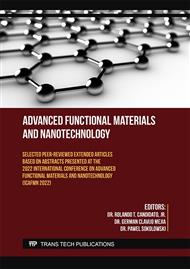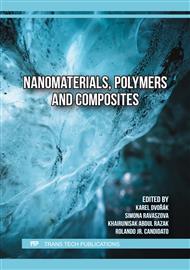[1]
S. Nemir, J.L, West, Synthetic materials in the study of cell response to substrate rigidity. Ann Biomed Eng., 38 (2009) 2–20.
DOI: 10.1007/s10439-009-9811-1
Google Scholar
[2]
E. Gutierrez and A. Groisman, Measurements of elastic moduli of silicone gel substrates with a microfluidic device. PLoS ONE, 6 (2011) e25534.
DOI: 10.1371/journal.pone.0025534
Google Scholar
[3]
J. Solon, I. Levental, K. Sengupta, P.C. Georges, P.A. Janmey, Fibroblast adaptation and stiffness matching to soft elastic substrates. Biophysical Journal, 193 (2007) 4453–4461.
DOI: 10.1529/biophysj.106.101386
Google Scholar
[4]
M.L. Byron, and E.A. Variano, Refractive-index-matched hydrogel materials for measuring flow-structure interactions. Exp Fluids, 54 (2013) 1456, http://
DOI: 10.1007/s00348-013-1456-z
Google Scholar
[5]
C.E. Kandow, P.A. Janmey, and K.A. Benigno, Polyacrylamide hydrogels for cell mechanics. Methods Cell Biol. 83 (2007) 29-46.
DOI: 10.1016/s0091-679x(07)83002-0
Google Scholar
[6]
R.J. Pelham and Y.L. Wang, Cell locomotion and focal adhesions are regulated by substrate flexibility. Proc Nat Acad Sci USA, 94 (1997) 13661–13665.
DOI: 10.1073/pnas.94.25.13661
Google Scholar
[7]
A.J. Engler, L. Bacakova, C. Newman, A. Hategan, et al., Substrate compliance versus ligand density in cell on gel responses. Biophys J. 56 (2004) 617–628.
DOI: 10.1016/s0006-3495(04)74140-5
Google Scholar
[8]
T. Boudou, J. Ohayon, C. Picart and P. Tracqui,. An extended relationship for the characterization of Young's modulus and Poisson's ratio of tunable polyacrylamide gels. Biorheology, 43 (2006) 721– 728.
Google Scholar
[9]
A. Engler, L. Richer, J.Y. Wong, C. Picart and D.E. Disher, Surface probe measurements of the elasticity of sectioned tissue, thin gels and polyelectrolyte multilayer films: Correlations between substrate stiffness and cell adhesion. Surface Science, 570 (2004) 142-154.
DOI: 10.1016/j.susc.2004.06.179
Google Scholar
[10]
L. Liqi Fangt, and W. Brown, Dynamic properties of polyacrylamide gels and solutions. Polymer, 31 (1990) 1960-1967.
Google Scholar
[11]
V. Normand, D.L. Lootens, E. Amici, K.P. Plucknett, P. Aymard, New insight into agarose gel mechanical properties. Biomacromolecules, 1 (2000) 730–738.
DOI: 10.1021/bm005583j
Google Scholar
[12]
S.R. Peyton and A.J. Putnam, Extracellular matrix rigidity governs smooth muscle cell motility in a biphasic fashion. J Cell Physiol, 204 (2005) 198–209.
DOI: 10.1002/jcp.20274
Google Scholar
[13]
J. Schramm-Baxter, J. Katrencik and S. Mitragotri, Jet injection into polyacrylamide gels: investigation of jet injection mechanics. J Biomech, 37 (2004) 1181–1188.
DOI: 10.1016/j.jbiomech.2003.12.006
Google Scholar
[14]
R.M. Delaine-Smitha, S. Burneya, F.R. Balkwillb and M.M. Knight, Experimental validation of a flat punch indentation methodology calibrated against unconfined compression tests for determination of soft tissue biomechanics. J Mech Behav Biomed Matter. 60 (2016) 401–415.
DOI: 10.1016/j.jmbbm.2016.02.019
Google Scholar
[15]
H.J. Kong, E. Wong E and D.J. Mooney, Independent control of rigidity and toughness of polymeric hydrogels. Macromolecules., 36 (2003) 4582–4588.
DOI: 10.1021/ma034137w
Google Scholar
[16]
N.A. Hammond and R.D. Kamm, Mechanical characterization of self-assembling peptide hydrogels by microindentation. J Biomed Matter Res B, 101 (2013) 981–990.
DOI: 10.1002/jbm.b.32906
Google Scholar
[17]
D.C. Lin DC, B. Yurke and N.A. Langrana, Inducing reversible stiffness changes in DNA-crosslinked gels. J. Mater Res. 20 (2005) 1456–1464.
DOI: 10.1557/jmr.2005.0186
Google Scholar
[18]
D.C. Lin, B. Yurke and N.A. Langrana, Mechanical properties of a reversible, DNA-crosslinked polyacrylamide hydrogel. J Biomech Eng., 126 (2004) 104–110.
DOI: 10.1115/1.1645529
Google Scholar
[19]
C.M. Buffinton, K.J. Tong, R.A. Blaho, E.M. Buffinton and D.M. Ebenstein, Comparison of mechanical testing methods for biomaterials: pipette aspiration, nanoindentation, and macroscale testing. J Mech Behav Biomed Mater, 51 (2015) 367–379.
DOI: 10.1016/j.jmbbm.2015.07.022
Google Scholar
[20]
T. Boudou, J. Ohayon, C. Picart and P. Tracqui, An extended relationship for the characterization of Young's modulus and Poisson's ratio of tunable polyacrylamide gels. Biorheology, 43 (2006) 721–728.
Google Scholar
[21]
Y. Abidine, V.M. Laurent, R. Michel, A. Duperray, L.L. Palade and C. Verdier, Physical properties of polyacrylamide gels probed by AFM and rheology. EPL, 109 (2015) 38003.
DOI: 10.1209/0295-5075/109/38003
Google Scholar
[22]
J.G. Jacot, S. Dianis J., Schnall and J.Y. Wong, A simple microindentation technique for mapping the microscale compliance of soft hydrated materials and tissues. J Biomed Mater Res A, 79 (2006) 485–494.
DOI: 10.1002/jbm.a.30812
Google Scholar
[23]
F.M. Hecht, J. Rheinlaender, N. Schierbaum, W.H. Goldmann, B. Fabry and T.E. Schaffer, Imaging viscoelastic properties of live cells by AFM: power-law rheology on the nanoscale. Soft Matter, 11 (2015) 4584.
DOI: 10.1039/c4sm02718c
Google Scholar
[24]
Y. Abidine, V.M. Laurent, R. Michel, A. Duperray and C. Verdier, Comput. Methods Biomech. Biomed. Eng. 16 (2013) 15.
Google Scholar
[25]
M.G. Ondeck and A.J. Engler, Mechanical characterization of a dynamic and tunable methacrylated hyaluronic acid hydrogel. J Biomech Eng., 138 (2016) 021003.
DOI: 10.1115/1.4032429
Google Scholar
[26]
C. Franck, S.A. Maskarinec, D.A. Tirrell and G. Ravichandran, Three-Dimensional Traction Force Microscopy: A New Tool for Quantifying Cell-Matrix Interactions. PLoS ONE., 6 (2011) 3 e17833.
DOI: 10.1371/journal.pone.0017833
Google Scholar
[27]
B. Álvarez-González, S. Zhang, M. Gómez-González, R. Meili, R.A. Firtel, J.C. Lasheras and J.C. del Álamo, Two-Layer Elastographic 3-D Traction Force Microscopy. Scientific Reports, 7 (2017) 39315.
DOI: 10.1038/srep39315
Google Scholar
[28]
S. Oura, M. Ito, D. Nii, Y. Homma and K. Umemura, Biomolecular recognition ability of RecA proteins for DNA on singled-walled carbon nanotubes, Colloids and Surf. B: Biointerfaces, 126 (2015) 496-501.
DOI: 10.1016/j.colsurfb.2015.01.002
Google Scholar
[29]
S. Awasthi, J.K. Gaur, M.S. Bobji, et al. Nanoparticle-reinforced polyacrylamide hydrogel composites for clinical applications: a review. J Mater Sci (2022) 57, 8041–8063.
DOI: 10.1007/s10853-022-07146-3
Google Scholar
[30]
J. Zemla, J. Bobrowska, A. Kubiak, T. Zielinski, J. Pabijan, K. Pogola, P. Bobrowski, M. Lekka, Indenting Soft Samples (hydrogels and cells) with cantilevers possessing various shapes of probing tip, European Biophysics Journal (2020) 49:485-495
DOI: 10.1007/s00249-020-01456-7
Google Scholar
[31]
R. L. Reserva, J.L.D C. Filipinas, M.J. Y. Jerez and M.N.P. Confesor, Non-equilibrium tracer dynamics in an oscillating active gel, Physica A (2022) 603 127812
DOI: 10.1016/j.physa.2022.127812
Google Scholar
[32]
M. J. Y. Jerez, M.A. Bonachita and M.N.P. Confesor, Dyanmics of a rachet gear powered by an active granular bath, PRE 101 (2020)
DOI: 10.1103/physreve.101.022604
Google Scholar



